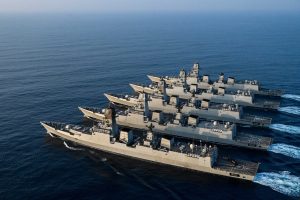India’s maritime aspirations have long revolved around the dream of a blue water navy – one capable of projecting power far from its shores. But as geopolitical realities shift in the Indian Ocean Region (IOR), it is time for New Delhi to rethink the very definition of “blue water” in an Indian context.
The traditional Western definition, born in the Atlantic and Pacific theaters, may not fully capture the nuances of India’s strategic geography and regional priorities. Instead, India must Indianize the concept – tailoring it to the unique challenges and opportunities presented by the Indian Ocean, from the Persian Gulf to the Sunda Strait, and as far south as the 60th parallel.
This recalibration is more than semantic. It’s a necessary strategic pivot that calls for an integrated maritime doctrine, one that transcends narrow military thinking and embraces the economic, cultural, and diplomatic dimensions of influence. Only through such a holistic approach can India secure its maritime interests, counter rising Chinese assertiveness, and emerge as the net security provider in the IOR.
In most Western naval doctrines, a blue water navy refers to a maritime force capable of sustained operations across the deep waters of open oceans, typically far beyond a nation’s territorial waters. The emphasis is on global reach, aircraft carriers, nuclear submarines, and power projection. While India’s naval capabilities are steadily evolving – evidenced by indigenous aircraft carriers, nuclear submarines, and expanded basing agreements – this standard definition may not be entirely suitable.
India’s maritime priorities are deeply rooted in its civilizational ties, trade networks, and diaspora across the IOR. It is not the Atlantic or Pacific that shapes India’s future, but the vast arc of the Indian Ocean – stretching from the African eastern seaboard to the western shores of Australia, and down to the Southern Ocean. To serve its strategic goals, India must redefine its blue water capability in this specific context – covering both the Eastern and Western flanks of the IOR and extending its vision down to 60 degrees South Latitude. Such a recalibration will better align India’s naval posture with its historical footprint and future imperatives.
India’s maritime rise is taking place amid intensifying strategic competition in the IOR. China’s naval expansion – manifested in its growing presence at ports like Gwadar, Djibouti, and potentially in East Africa and the Maldives – has introduced a new layer of complexity. The People’s Liberation Army Navy (PLAN) has increased its deployments, submarine patrols, and military logistics capabilities across the IOR, testing India’s ability to remain the primary security actor in its own backyard.
Beyond traditional military threats, the region faces nontraditional challenges: piracy off the Horn of Africa, narco-trafficking, illegal fishing, rising sea levels, and climate-induced displacement. India’s current maritime frameworks, including the Indian Maritime Security Strategy (IMSS) and the Security and Growth for All in the Region (SAGAR) vision, address these issues only in parts. What’s missing is a comprehensive framework that fuses strategic deterrence with soft power and developmental diplomacy.
A truly Indianized maritime doctrine must look beyond ships, submarines, and shore-based missile systems. While military preparedness is essential, India must build a broader toolkit – leveraging economic, diplomatic, and cultural instruments to shape the regional order.
Economically, India must invest in regional port infrastructure, offer viable alternatives to China’s Belt and Road Initiative (BRI), and champion a sustainable blue economy. Diplomatically, deeper engagement with IORA, BIMSTEC, and emerging platforms like the Indo-Pacific Oceans Initiative (IPOI) can cement India’s leadership role. Culturally, civilizational links – through Buddhism, shared colonial histories, and the Indian diaspora – offer untapped soft power reservoirs that can forge deeper bonds with IOR nations.
Politically, New Delhi must reinforce its reputation as a reliable partner through disaster relief, vaccine diplomacy, and capacity-building efforts. Maritime Domain Awareness (MDA), coordinated patrols, and joint naval exercises can build trust with smaller littoral states like Seychelles, Mauritius, and Sri Lanka, which often find themselves caught between great powers.
Despite multiple initiatives – SAGAR, the Indo-Pacific policy, the IMSS, and bilateral naval partnerships – India’s maritime strategy remains fragmented. What is needed is an overarching maritime doctrine that aligns national objectives across ministries, agencies, and services. Such a doctrine could integrate security, commerce, diplomacy, environment, and technology into a unified framework.
This umbrella policy should articulate India’s maritime ambitions clearly: maintaining regional stability, ensuring freedom of navigation, countering Chinese militarization, and positioning India as a civilizational maritime power. A national maritime commission or task force could be instrumental in achieving inter-agency coherence and long-term strategic vision.
India must enhance indigenous shipbuilding, develop dual-use ports in the Andaman and Nicobar Islands and in Lakshadweep, and invest in maritime startups focused on ocean tech, surveillance, and sustainability. Strategic agreements with key nations – France, Australia, Indonesia, and Kenya – should be deepened. Moreover, India should position itself as a climate leader in the IOR, addressing the vulnerabilities of island nations through green energy and climate-resilient infrastructure.
This multidimensional strategy will not only help India outcompete China in the IOR but also allow it to fulfill its historic role as a benign and stabilizing force in the Indian Ocean – just as it was in ancient times, when Indian ships, languages, and ideas sailed the seas long before gunboats did.
India’s blue water dream is not just about dominating oceans; it’s about reimagining them. By redefining what it means to be a maritime power in the 21st century, India can chart a course that is both ambitious and grounded in its unique geography, history, and civilizational ethos. A truly Indianized maritime doctrine, backed by comprehensive policy instruments, is not only necessary – it is inevitable. The Indian Ocean must not merely be India’s backyard. It must be India’s arena.
































